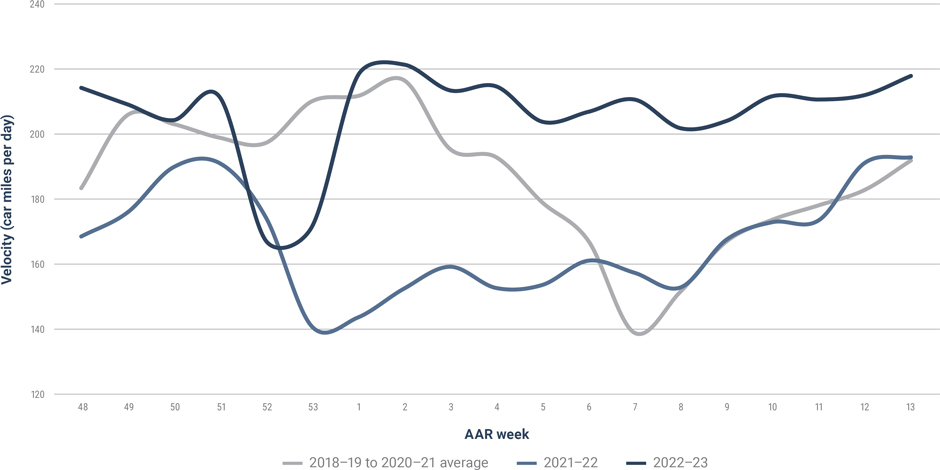Going into winter 2022-23, CN was confident that it had a comprehensive, strong, and realistic Winter Plan in place to help mitigate the harsh effects of a Canadian winter so that CN could deliver the best possible service and continue to power sustainable growth. Fundamental changes to CN’s rail operations and planning to effect improvements in operational performance were made in spring and summer 2022 to lay the base for a successful winter campaign.
Plenty of Cold to Go Around
To understand how the 2022-23 Winter Plan unfolded, it is important to look back at the actual weather conditions that occurred across the CN rail network, especially with respect to the frequency/intensity of both extreme cold temperatures and mainline rail disruptions. There is a direct relationship between the relative frequency and intensity of extreme cold temperatures during a given period and rail network productivity. When temperatures reach -25°C, CN implements train length restrictions to maintain safe rail operations and comply with Transport Canada regulations.
During winter 2022-23, the frequency of extreme cold (defined as -25°C or colder) was in line with average levels. This was in sharp contrast to winter 2021-22 when the frequency of extreme cold approached double of normal levels. There were also multiple instances during winter 2022-23 of multiple days of extreme cold back-to-back. In the Prairies, for example, these periods were December 1-7, December 17-24, January 26-February 3, and February 20-25. Compared to when CN experiences one or two days of extreme cold, much longer periods of persistent extreme cold have a more pronounced impact on rail operations because the ability to recover is delayed that much more.
Number of Days Where Minimum Temperatures Were -25°C or Colder During December – March
(Select Canadian weather stations across the CN network)

There were no major mainline disruptions across CN’s western Canadian network, while a mainline disruption near Grafton, ON commencing December 24 halted all traffic on the CN Kingston subdivision. CN crews worked around the clock in very difficult winter conditions to restore the track to a safe and usable state as quickly as possible, and operations on the CN Kingston subdivision resumed December 27.
Operational Performance Metrics Tell the Story
Velocity, which is the average number of miles that a car travels in a day, was resilient throughout winter 2022-23. Excluding late December, when multiple winter storms and persistent extreme cold weather affected Canada’s West Coast, the Prairies, the U.S. Midwest, and Eastern Canada all at the same time, average network-wide car velocity was in the 200 to 220 mile per day range. Notably, once extreme cold conditions abated after prolonged periods of extreme cold, CN network velocity recovered more quickly compared to previous winters. In fact, CN’s velocity this winter was on par with the velocity levels CN was achieving this past summer and fall.
Network-wide Weekly CN Car Velocity

Other key operational performance measures were also strong throughout winter 2022-23. CN industry train speed on the Canadian network was in the range of 25 miles per hour or higher throughout the winter, excepting late December. Industry terminal dwell was also consistently well below average levels.
Keys to Success – Discipline and Communication
That CN was able to deliver such strong, consistent performance during winter 2022-23 is no fluke. CN experienced a typical Canadian winter, not a mild one by any stretch of the imagination. The fundamental changes that CN made to its rail operations and planning in spring-summer 2023 to effect improvements in operational performance delivered the desired results.
CN increased the frequency of internal coordination and planning calls to enhance the impact of changes that CN made to its operations plan this past spring and summer, and CN ensured it had the right level resources in place, including recruiting and training conductors.
CN was disciplined when challenged with extreme weather conditions. CN’s focus on ensuring that local rail service was adjusted to match the capacity of the mainline network to accept that traffic during periods of extreme weather was key in allowing network productivity to recover much more quickly at the end of any prolonged period of widespread extreme winter weather. Conservative early implementation of train length restrictions before extreme cold developed in the first place was also a key measure that supported a quicker recovery in velocity once extreme cold conditions eased.
Summary
By taking the comprehensive, coordinated, and collaborative approach outlined in the 2022-23 Winter Plan CN was as well-positioned as possible to meet the challenge of winter 2022-23 head on. The breadth of the integrated actions and the scale of the planning were designed to ensure CN was able to deliver the best possible service during the winter months. The foundation for the steps CN took was based on safety, delivering the best possible service, increasing network productivity, and improving resilience.
LEARN MORE ABOUT GRAIN